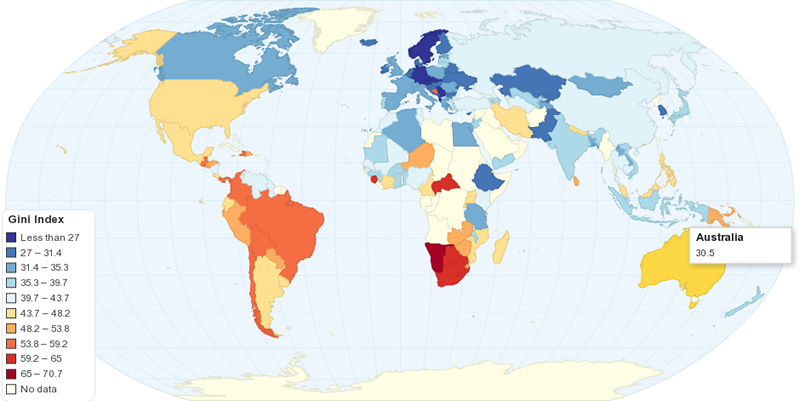Lesson 10: Global Inequality
Attention

This map shows the GINI Coefficient for countries around the globe...The GINI is a measure of the equal distribution of wealth with 1 being absolute equality and 100 meaning absolute inequality.
Learning Outcomes
Upon completion of this lesson's material, students will be able to:
- Contrast the World Systems and the World Bank's classification of economies.
- Describe the ethics of the modernization and dependency theory perspectives on global stratification.
Teaching
Globalization
Globalization was introduced early in this course as a major source of change in our society. There is no doubt that we currently live in global economies where the economic health of different countries impact us here at home.
Consider the introductory story in Chapter 10 of the text. When we buy inexpensive clothes, it is very likely that we are buying clothes that have been manufactured outside of the US. It is also very likely that the conditions under which the clothing is manufactured would not be acceptable to us. The pay, the cleanliness, and the safety of the factories would fall way below our standards. That is how the keep the prices so low.
Consider adding that to your Sociological Imagination!
Global Stratification and the Gini Coefficient
While we can see a great deal of inequality in our own country, this is nothing compared to the wide degree of inequality on a global scale. Consider the statistic by Oxfam (2014) in our text which states that the top riches 85 people have more money than the poorest 3.5 billion!!
One of the ways in which Sociologists (and Economists) look at global inequality is with a statistic called the Gini Coefficient. This number, from 1-100, represents the degree to which wealth is equally distributed among the members of a nation. 1 would mean that EVERYONE had the same amount of wealth and 100 would mean that only 1 person would hold ALL the wealth (neither of these situations exist...but the closer to 1 a nation gets the more equally the wealth of that nation is divided among its citizens.)
Click HERE to visit the World Bank's website that reports out trends across the world in terms of the Gini Coefficient.
Systems of Classification
Being able to take a look at global inequality requires us to use some new terminology. There are two current systems of classification, the "World Systems Approach" and the "World Bank Classification by Income" systems.
These are covered in the text, but are worth reviewing here.
World Systems Approach
- Core Nations - highly industrialized, technological, and urbanized (United States, Canada, etc.).
- Peripheral Nations - very little industrialization, unstable governments, inadequate social programs (Vietnam, Cuba, etc.).
- Semi- Peripheral Nations - not powerful enough to dictate policy, but sources of raw materials and other sources (Mexico)
World Bank Classification by Income
- High Income Nations - GNI (Gross National Income) per Capita - $43,903
- Middle Income Nations - GNI (Gross National Income) per Capita - $1,045 - $12,746
- Low Income Nations - GNI (Gross National Income) per Capita - lesson that $1,045
Why is the United States seen as so Rich? It might be useful to compare the MASSIVE wealth in the United States to the low income status of Low Income Nations in this way. According to the US Department of Health and Human Services, the Poverty Rate for 2016 is $11,880 per year for a single person (click HERE to see all the guidelines for larger families.) Now, let's do some math...a single person making $11,879 per year would be considered in "Poverty"...this would be about $989.92 per month. So let's compare...the POVERTY rate PER MONTH for a person in the US is only $55.08 less than the Low Income Nation income PER YEAR ($1,045)!!! |
Poverty
After looking at the information in the box above, how can there be any poverty in the US? Well, there are different kinds of poverty.
- Relative Poverty - can afford the necessities, but not the accepted standard of living.
- Absolute Poverty - cannot afford the necessities.
- Subjective Poverty - actual income does not meet your expectations
So what is going on??
Modernization Theory
- An adjustment of cultural values and attitudes toward work.
- Industrialization and other forms of economic development.
Dependency Theory
- Core nations exploiting semi-peripheral and peripheral nations.
Assessment

Lesson 10 Discussion
In this discussion I would like you to think about the Modernization and Dependency theories that explain inequality. You have learned about "ethnocentrism" in this class already. What are the ethical issues related to these two theories of why there is global inequality?
Lesson 10 Quiz
- Contrast the World Systems and World Bank Classification systems. (To contrast means to define both and explain how they are different from one another.)